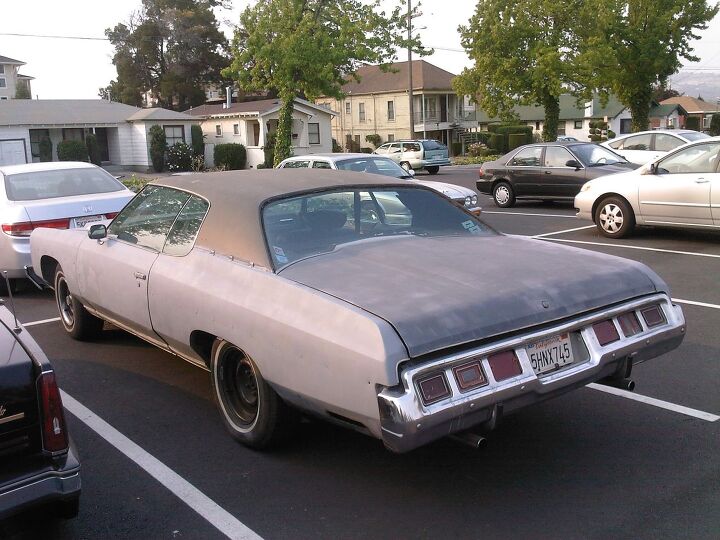Down On The Oakland Street: Daily-Driven 1973 Chevrolet Caprice

Normally, I don’t consider parking-lot photos for variations of the “interesting car parked in public” schtick, but this Caprice is special: it parks in a train-station parking lot in the roughest neighborhood in East Oakland. Every day.
Well, it parked there every day as recently as last summer, when I was still attending plenty of Oakland Athletics games and parking in the Coliseum BART lot.
The Chevy B-body of this period was a pretty decent car, with a sophisticated-for-1970s-Detroit 4-link rear suspension and reliable (if somewhat oil-leak-challenged) engines; I’ve owned a few of these and they were great daily drivers. In 1973 the big Chevy was still selling in vast quantities. How many? According to the Standard Catalog, 941,104 full-sized Chevrolets rolled off the assembly line. Interestingly, big Ford production was nearly identical, with 941,054 Galaxies, LTDs, and Custom 500s sold for the model year.
Judging by the early-70s Chevrolets you see around these days, one might get the impression that the Camaro, Corvette, and Nova were the biggest sellers. If not for the donk and lowrider crowds, even fewer Early Malaise Era Impalas and Caprices would have escaped the jaws of the Crusher… and with scrap steel now going for $250/ton, plenty of the few surviving never-got-around-to-the-project GM B-bodies now sitting in back yards and driveways are going to get eaten in the near future.

Murilee Martin is the pen name of Phil Greden, a writer who has lived in Minnesota, California, Georgia and (now) Colorado. He has toiled at copywriting, technical writing, junkmail writing, fiction writing and now automotive writing. He has owned many terrible vehicles and some good ones. He spends a great deal of time in self-service junkyards. These days, he writes for publications including Autoweek, Autoblog, Hagerty, The Truth About Cars and Capital One.
More by Murilee Martin
Latest Car Reviews
Read moreLatest Product Reviews
Read moreRecent Comments
- TheEndlessEnigma These cars were bought and hooned. This is a bomb waiting to go off in an owner's driveway.
- Kwik_Shift_Pro4X Thankfully I don't have to deal with GDI issues in my Frontier. These cleaners should do well for me if I win.
- Theflyersfan Serious answer time...Honda used to stand for excellence in auto engineering. Their first main claim to fame was the CVCC (we don't need a catalytic converter!) engine and it sent from there. Their suspensions, their VTEC engines, slick manual transmissions, even a stowing minivan seat, all theirs. But I think they've been coasting a bit lately. Yes, the Civic Type-R has a powerful small engine, but the Honda of old would have found a way to get more revs out of it and make it feel like an i-VTEC engine of old instead of any old turbo engine that can be found in a multitude of performance small cars. Their 1.5L turbo-4...well...have they ever figured out the oil dilution problems? Very un-Honda-like. Paint issues that still linger. Cheaper feeling interior trim. All things that fly in the face of what Honda once was. The only thing that they seem to have kept have been the sales staff that treat you with utter contempt for daring to walk into their inner sanctum and wanting a deal on something that isn't a bare-bones CR-V. So Honda, beat the rest of your Japanese and Korean rivals, and plug-in hybridize everything. If you want a relatively (in an engineering way) easy way to get ahead of the curve, raise the CAFE score, and have a major point to advertise, and be able to sell to those who can't plug in easily, sell them on something that will get, for example, 35% better mileage, plug in when you get a chance, and drives like a Honda. Bring back some of the engineering skills that Honda once stood for. And then start introducing a portfolio of EVs once people are more comfortable with the idea of plugging in. People seeing that they can easily use an EV for their daily errands with the gas engine never starting will eventually sell them on a future EV because that range anxiety will be lessened. The all EV leap is still a bridge too far, especially as recent sales numbers have shown. Baby steps. That's how you win people over.
- Theflyersfan If this saves (or delays) an expensive carbon brushing off of the valves down the road, I'll take a case. I understand that can be a very expensive bit of scheduled maintenance.
- Zipper69 A Mini should have 2 doors and 4 cylinders and tires the size of dinner plates.All else is puffery.














































Comments
Join the conversation
Disc brakes became mandatory on all passenger cars in 76. They were standard equipment on the fullsize chevy starting around 71. These cars wer not mechanically stout at all, and only held up under pretty sedate driving conditions. The blocks had a pretty low nickel content, and they started burning oil between 80-100k. And you had the famous chevy cam wear problems due to the soft cams and narrow lobes and small lifters, which didn't give as much of a wear surface. And small block chevies were famous for leaking valve covers due to the 4 bolt valve cover design and thin flanges, and the seal between the timing cover and oil pan was known to leak as well. Starting in 75 they made the decks on the heads thinner and they had cracking problems. The 400 ran hot, and the heads were prone to cracking between the extra steam holes drilled in the deck surface between the combustion chambers. The use of the turbo 350 behind the 350 and most 400 engines in a car this size was a joke, and a prime example of GM's cost cutting.
If I'm not mistaken disc brakes were standard on this car starting with this body style in 71.